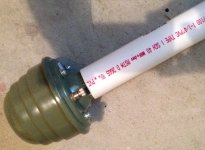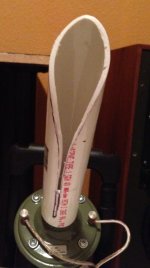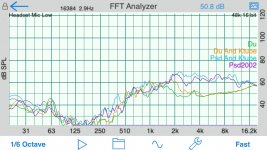is there a difference...
as far as I am concerned yes there is a significant difference. The double cut away version has less left to right room and tube to tube interaction so stage and image is much improved. I run my K-Tubes parallel to the floor centred at seated ear level and I position them so the the solid sides are left and right so the slot between them is vertical and I point the tubes directly at my head or shoulders depending upon the room. This for me works and sounds better than any horns I have tried so far to the point where I have no interest in horns at this point. Best regards Moray James.
PS: am running an EV DH1A most impressive driver.
Hi,
Is there any audible difference between single cut tube and the bishop's hat?

as far as I am concerned yes there is a significant difference. The double cut away version has less left to right room and tube to tube interaction so stage and image is much improved. I run my K-Tubes parallel to the floor centred at seated ear level and I position them so the the solid sides are left and right so the slot between them is vertical and I point the tubes directly at my head or shoulders depending upon the room. This for me works and sounds better than any horns I have tried so far to the point where I have no interest in horns at this point. Best regards Moray James.
PS: am running an EV DH1A most impressive driver.
Last edited:
Thanks a lot for the insight. 
And WOW, that's completely beyond my imagination. I thought there'd be significant 'leak' at the slots, so the dispersion would be very wide by placing the 2 slots horizontally. (If that's the case, than it's more like a cartoonish duck beak, LOL)
As to the length of tube, is the cutoff simply defined by 1/4 lambda? Say, it I need a 500Hz tube, than the overall length would be 17.2 cm. (= 344/500/4 m) Is that right?
And WOW, that's completely beyond my imagination. I thought there'd be significant 'leak' at the slots, so the dispersion would be very wide by placing the 2 slots horizontally. (If that's the case, than it's more like a cartoonish duck beak, LOL)
As to the length of tube, is the cutoff simply defined by 1/4 lambda? Say, it I need a 500Hz tube, than the overall length would be 17.2 cm. (= 344/500/4 m) Is that right?
Thanks a lot for the insight.
And WOW, that's completely beyond my imagination. I thought there'd be significant 'leak' at the slots, so the dispersion would be very wide by placing the 2 slots horizontally. (If that's the case, than it's more like a cartoonish duck beak, LOL)
As to the length of tube, is the cutoff simply defined by 1/4 lambda? Say, it I need a 500Hz tube, than the overall length would be 17.2 cm. (= 344/500/4 m) Is that right?
As the tube goes from fully-enclosed space to actually terminating, though gradually so, it does have what I feel to be an effective length shorter than the full pipe material. I figure 90% of the full length at best, but probably best to make the whole tube a solid 2x the length suggested by c/F/4, so c/F/2, half-wave
Looking at the response and distortion I posted of BMS 4550 on the 5.3" Transylvania tube, we can see that use below 1kHz is getting sketchy. I guess 800Hz with a 4th order slope would be fine for home use though. The driver should have a fairly low Fs and suggested Xover point.
I suppose at some point, making it too long will probably require a narrower, more progressive slot, possibly giving rise to more attenuation above the HF cutoff frequency, determined by the internal diameter AFAICT, much like a PWT. The 5.3" long tube does have a good HF output IMO though.
Last edited:
Found some suitable pipe (currently 2 ft long) that the driver can securely screw into. I won't be able to measure the raw response / impedance or cut the slot till this weekend
I guess I'd suggest first trying to make a tube proportional to the Transylvania unit. Since you have 1.25" PVC, I'd make the slotted length 6.625" long and only keep enough "stub" to screw into and perhaps make a smoother transition with some blue-tak or putty. This should provide a fair load into the 600Hz range I surmise. Adding a longer "stub" section might take that lower, but could introduce unwanted artifacts. Only testing will reveal that.
I started out with about an 8" long pipe, sketched something approximating a mirrored exponential slot on a piece of paper and transferred the profile to the pipe. I carved the profile using a cut off wheel on my dremel.
Update:
For now, I started the cut about 1/3 of the way along the length. The k-tube for now sounds better than the uncut tube but it still sounds somewhat hollow and resonant. On the plus side, the dispersion is rather good. Using a frequency generator on my phone, the sound seems to pick up around the quarter wave frequency of 400 Hz
I think I need to start the curve earlier and open it out a bit faster and should probably take measurements as I continue to mangle the tube.
Update:
For now, I started the cut about 1/3 of the way along the length. The k-tube for now sounds better than the uncut tube but it still sounds somewhat hollow and resonant. On the plus side, the dispersion is rather good. Using a frequency generator on my phone, the sound seems to pick up around the quarter wave frequency of 400 Hz
I think I need to start the curve earlier and open it out a bit faster and should probably take measurements as I continue to mangle the tube.
Attachments
Last edited:
My experience with K-Tubes from 2 inches to 10 in diameter have always
been that they sound better the more and more you cut away until there
is nothing left...
I believe in K15. Improvement over vented box alignment is undeniable.
After experiencing K15, I bought-into K-Tubes with great faith and was
totally disappointed. And its not like I gave up on the first or 10th try...
Whatever magic is supposedly possible with K-Tubage, if not total "BS",
is not trivial to replicate. Else I should have stumbled upon something
close to an acceptable alignment, and that event just never happened.
been that they sound better the more and more you cut away until there
is nothing left...
I believe in K15. Improvement over vented box alignment is undeniable.
After experiencing K15, I bought-into K-Tubes with great faith and was
totally disappointed. And its not like I gave up on the first or 10th try...
Whatever magic is supposedly possible with K-Tubage, if not total "BS",
is not trivial to replicate. Else I should have stumbled upon something
close to an acceptable alignment, and that event just never happened.
the open slot in my double cutaway K-Tube is vertical...
Thanks a lot for the insight.
And WOW, that's completely beyond my imagination. I thought there'd be significant 'leak' at the slots, so the dispersion would be very wide by placing the 2 slots horizontally. (If that's the case, than it's more like a cartoonish duck beak, LOL)
the tube is parallel to the floor. The solid sections of the tubes are to the left and right of the slot with the tubes at my seated eat level pointing directly at my head. The compression driver diaphragm has been aligned in the same plane as the woofer by ear. The slot stops short of the end of the tube by about 3/8". I have done this with compression drivers and with dome tweeters. I don't see what would be difficult about this to replicate. All you need is a driver some paper scotch tape and a pair of scissors.
If someone else experiments with this and they cannot make theirs work that does not mean that mine have stopped working. Best regards Moray James.
Last edited:
An externally hosted image should be here but it was not working when we last tested it.
I started out with about an 8" long pipe, sketched something approximating a mirrored exponential slot on a piece of paper and transferred the profile to the pipe. I carved the profile using a cut off wheel on my dremel.
Update:
For now, I started the cut about 1/3 of the way along the length. The k-tube for now sounds better than the uncut tube but it still sounds somewhat hollow and resonant. On the plus side, the dispersion is rather good. Using a frequency generator on my phone, the sound seems to pick up around the quarter wave frequency of 400 Hz
I think I need to start the curve earlier and open it out a bit faster and should probably take measurements as I continue to mangle the tube.
Cool! I guess the profile deviates a bit from a half-ellipse but it still looks ballpark to me.
My experience with K-Tubes from 2 inches to 10 in diameter have always
been that they sound better the more and more you cut away until there
is nothing left...
Did you have the same experience with 1" K-Tubes?
The double cut away version has less left to right room and tube to tube interaction......
Makes sense to me if I’m visualizing it correctly; a tube has a theoretical ~231.8 deg F6, but bifurcating it with a tapered slot is going to bleed a progressive amount of pressure out, so starts out omni, progressively collapsing into whatever beam-width pattern the tube’s final taper dictates same as any WG. Seems worth pursuing for folks not wanting a really wide ‘sweet spot’.
GM
As the tube goes from fully-enclosed space to actually terminating, though gradually so...........
I suppose at some point, making it too long will probably require a narrower, more progressive slot..........
Correct, though how much shorter is a function of its acoustical end correction AFAIK, i.e. you will have to calculate its effective final flare, then subtract ~0.613 x the radius of this much larger termination [Am] from the tube’s physical length.
I’ve no clue how to accurately convert a flared cutout along a tube’s length to a flared circular extension to get its [Am] though. Maybe ‘xrk971’ can approximate it in AKAbak like he does the K-slot. Otherwise, your ½ WL seems a reasonable choice and shorten it if need be.
Agreed, my SWAG is that the longer the tube, the wider its potential BW for a given diameter same as a horn, so calculating a slot taper would be basically no different than designing a tiny exponential horn of the same length, [Am], ergo using a [At] = to a typical ~1/16” wide saw blade, this equates to a ~48,446 Hz cut-off if I did the math right.
GM
Correct, though how much shorter is a function of its acoustical end correction AFAIK, i.e. you will have to calculate its effective final flare, then subtract ~0.613 x the radius of this much larger termination [Am] from the tube’s physical length.
I’ve no clue how to accurately convert a flared cutout along a tube’s length to a flared circular extension to get its [Am] though. Maybe ‘xrk971’ can approximate it in AKAbak like he does the K-slot. Otherwise, your ½ WL seems a reasonable choice and shorten it if need be.
Agreed, my SWAG is that the longer the tube, the wider its potential BW for a given diameter same as a horn, so calculating a slot taper would be basically no different than designing a tiny exponential horn of the same length, [Am], ergo using a [At] = to a typical ~1/16” wide saw blade, this equates to a ~48,446 Hz cut-off if I did the math right.
GM
Thanks for that insight!
Equating the tube to a small horn for analysis is something I've wanted to do ever since I've had my pair of Transylvania. I'm not hip enough on theory to approach this outside of taking comparative measurements. Best I can do is cut a bunch of PVC tubes and see what I can cross-correlate, if anything at all.
I think the effective throat area will always be that of the tube diameter, unless the slot starts really wide right away, which it should not IMO, to keep some loading on the driver. As we move up (out of) the tube, that's where the gradual loss of pressure needs equation to a horn profile and mouth area - unknowns to me.
Measured the k tube on the midrange compression driver as well as on an eminence psd2002 (more efficient ). Instead of the u-mik and REW on my laptop, I used my iphone , audiotools and the cheap dayton imic
The psd2002 sounds better, despite a higher resonant frequency
The psd2002 sounds better, despite a higher resonant frequency
Attachments
you could make a 1"ID tube with 5.3" full length slot for comparisons. Eminence's drivers worked well with K-tubes. For some reason (internal flare) IG's Emilar did not mate well. Although patterns may not be a perfect match, I think the little K-tube overall sounds better than CD horn in some applications were `1K5 xover is employed.
For some reason (internal flare) IG's Emilar did not mate well.
Not certain the throat angle mismatch would account for as large an effect as that dip I got. Looking at certain traces of BMS 4550 on the Tube, there is also a little something, as well as a bit more distortion at that frequency. I'm wondering how the two drivers would compare measured in the far-field, like a good 10' or so, which I can't really do well indoors. I also used D220Ti at first on the tube, but don't think I kept any crossover-less plots of it.
5.3" (1"ID) copying Transylvania Power's "The Tube" length is the shortest I tried. For smooth plots there should be little diameter transition. Before going to a totally bare compression driver, try the Weiss lens which mounted on a Type1 Eminence.
Weiss "Rocket" patio speaker which used either a Radio Shack 8 or BOFU

An externally hosted image should be here but it was not working when we last tested it.
Weiss "Rocket" patio speaker which used either a Radio Shack 8 or BOFU

Last edited:
you could make a 1"ID tube with 5.3" full length slot for comparisons. Eminence's drivers worked well with K-tubes. For some reason (internal flare) IG's Emilar did not mate well. Although patterns may not be a perfect match, I think the little K-tube overall sounds better than CD horn in some applications were `1K5 xover is employed.
Okay, I'll try and make something up with a 1" ID tube to compare. The trick will be to adapt it to the larger screw in compression driver.
5.3" (1"ID) copying Transylvania Power's "The Tube" length is the shortest I tried. For smooth plots there should be little diameter transition. Before going to a totally bare compression driver, try the Weiss lens which mounted on a Type1 Eminence.
An externally hosted image should be here but it was not working when we last tested it.
Weiss "Rocket" patio speaker which used either a Radio Shack 8 or BOFU

A bit off topic, but looking at the rocket speaker, .. that's a sealed speaker with a K-slot waveguide. Is that the same as the old Magenetar Klam subwoofer? I've got a dozen 12" subwoofers (with Qts about 0.7 and low Fs )lying around (long story ...) as well as pair of low Qts pyle PYM 1298 and I'm wondering if they would be suitable in a Klam bass module, and what the upper and lower bound of a Klam design would be.
Last edited:
- Status
- This old topic is closed. If you want to reopen this topic, contact a moderator using the "Report Post" button.
- Home
- Loudspeakers
- Full Range
- Midrange K-tube ?


